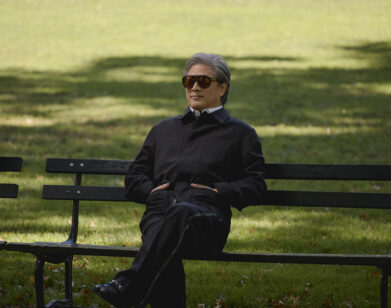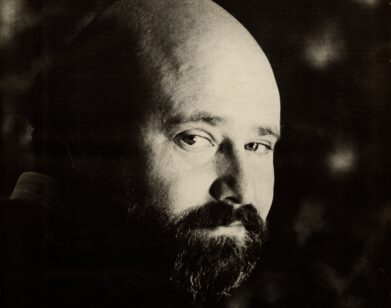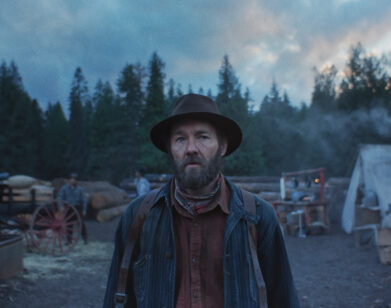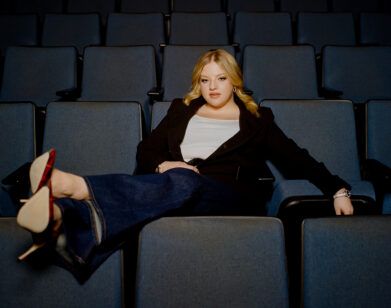The Gravity of Juan Solanas
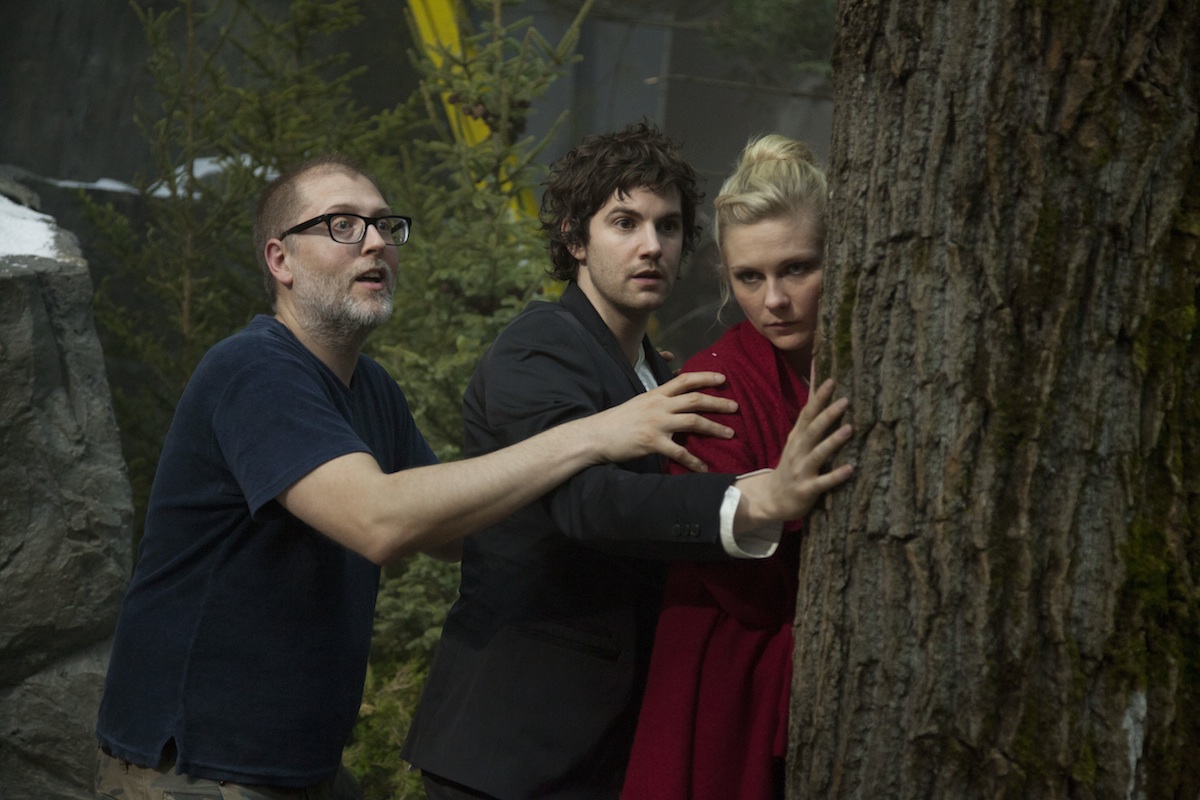
ABOVE: JUAN SOLANAS (LEFT) DIRECTS JIM STURGESS AND KIRSTEN DUNST IN UPSIDE DOWN.
Argentinean Juan Solanas isn’t just the son of 34-time award-winning filmmaker Fernando Solanas. He’s an award-winning filmmaker in his own right, who takes simple, clear images and transforms them into something whimsical and interesting. In his latest project, Upside Down, viewers are plunged into a universe where two planets, the aptly named Up and Down, developed on top of each other. It’s an in-your-face metaphor: Up is an affluent planet, with only wealthy people, while Down is a desolate wasteland, filled with the poor.
A Romeo and Juliet-esque love story ensues, but what sets the film apart from similar fare is Solanas’s fresh take on the age-old theme of class struggles. In the film’s world, you can tell just by looking at somebody that they’re below you, literally—if you’re from Down Below, your planet’s gravitational pull causes you to be physically below those from Up Top. The concept’s best seen in TransWorld, a corporation that offers employment to citizens of both planets, who work in the same room, but, depending on home planet, have desks either on the ceiling or the ground.
With its swirling clouds, mountain views, and upside-down skyscrapers, the film is visually stunning. Interview met with Solanas to discuss this image-driven approach, why he initially didn’t want to be a filmmaker, and the difficulties of shooting actors on ceilings.
CASSIE TITLE: Obvious things first: your dad’s a famous filmmaker. And I know you studied photography.
JUAN SOLANAS: Well, at the beginning of my life, I studied to be an astrophysicist.
TITLE: That’s so much more interesting than what I found! What happened?
SOLANAS: As an adolescent, I began taking pictures. I was feeling bad, and took my father’s camera, a Nikkormat. I developed the pictures and they were beautiful, so that was magical for me. Changing this depression into beauty. That became a drug for me, so two, three, four times a week, I’d go out and take pictures.
TITLE: Of anything?
SOLANAS: I have a thousand photos of sunsets. I love the Romantics: Turner, Caspar Friedrich. Then I started to have a very strong relationship with photography. I did one year of Physics at University, and then I made pictures for a living. So, I was a photographer making photos for CDs. And one day I did the light for a clip, and became a director of photography.
TITLE: Did growing up with a filmmaker have something to do with it?
SOLANAS: My father was a filmmaker, so I didn’t want to do that. I was like, no fucking way! And that’s why I took a lot of time to start to direct. But, I have a way of thinking in images. So, sometimes, an image appears to me.
TITLE: Upside Down is so visually stunning that I feel like the concept had to have come about through an image.
SOLANAS: The first time I directed, I didn’t want to be a director. But one day, I had a vision. I saw a man without a head. Nothing but his body. Then the story came. I just started to write it. And when I finished writing, it was 20 pages. I never saw a short movie before. I wrote that, and then I directed it, and I really discovered myself doing that. Like, “Wow, I want to do that, I love to do that.” It was obvious. And then I spent four years doing it, but at the end I won the prize in Cannes, and then prizes around the world, so that was crazy. I didn’t even know that in Cannes there was a short movie section. But then it was like, maybe I am a filmmaker.
TITLE: An affirmation!
SOLANAS: Two months after the prize in Cannes, I had the idea of Northeast, my first feature movie. And I started to write it. One year after it was shooting. After Northeast, one day I woke up, and I saw these two mountains. I don’t drive a car because of that. One day, I came close to killing myself [accidentally, while driving], so I don’t drive. Because sometimes I don’t see the road, I see an image, and that’s no good. So I saw the two mountains. Saw the guy, saw the girl. Understood the ramification of the north and the south, and I was like, “Shit! I think I’ve got to try and make a second movie. I just started writing the script the same day.” After two months, I had a full version of the script in Spanish.
TITLE: This is your first English feature.
SOLANAS: To tell you the truth, three years ago I didn’t speak one word of English.
TITLE: No way!
SOLANAS: I learned English three months before flying to Canada [to shoot the movie]. I started to write in Spanish, then I realized my producer was French, so I translated my first version to French to give to the producer. That was a pain in the ass. And I knew, from the beginning; it’s an expensive movie, if one day it happens, it’ll happen in English. We did the movie with the money of preselling. And to maximize that, it was in English. So that was a rational decision.
TITLE: I have another question about the actual images. I feel like The Man Without a Head and Upside Down both center on these really clear images that are simple concepts in a sense; this man literally has no head, Upside Down’s class struggle is shown through these affluent people that, because of Up’s gravitational pull, are literally and physically above the lower class in Down.
SOLANAS: When I write, I don’t know where I go. So my process is not intellectual, in the way you asked me the question. It’s trying to go very deep, and when things come out in this way, they are solid. And then I understand what they mean. Then I add layers around that.
TITLE: That’s how I used to write poetry. Still not sure if it was a good thing in my case. Was it hard to film?
SOLANAS: Oh, a nightmare! For all the double gravity scenes, I wanted to shoot it live. But you cannot put people on the ceiling.
TITLE: It’s pretty hard.
SOLANAS: So I used my physics background. I had a concept of the technology. We went to see the biggest companies in motion control and computer imaging, and all of them said to us: that’s very challenging, but we think it’s possible. And, they did it.
TITLE: So did you actually have cameras that were in the opposite direction?
SOLANAS: We had a set for each gravity. In one set we had a normal camera with a cameraman; my idea was that every movement of this camera was in real time. So, a computer calculated the reverse movement and gave a robot the reverse in real time. So basically, two cameras, one set. But when this one goes up, this one goes down. And we put, in each set, a video prompter, like for journalists. You know when a newscaster’s speaking and reading something? He looks to the camera but he’s really reading the text. We did that: they didn’t look at text, they looked at each other. Both actors were speaking to each other live, through the prompter, like it was normal.
TITLE: Going back to the beginning of the movie, your cinematography is dark, lush, and murky; it had a dreamlike quality. So it seemed to point to an intentional sense of confusion.
SOLANAS: Well, it was a memory. The past is always a little bit unrealistic, a little wilder. Because when you remember, you project. There’s a piece of reality, but then you put a lot around it.
TITLE: Let’s talk name choices: Adam and Eden. Originally she was supposed to be Eve.
SOLANAS: Yes. Because together they’re going to start a new world. But after people told me: “Oh, Bible,” I shifted it a little bit. But Eden is the paradise for him. These people Down Below pass their lives thinking that Up Top is paradise. And maybe they’re wrong, but he loved her, so, yes, she’s paradise.
TITLE: I got a real sense of a dystopian future. Was that something you were going for?
SOLANAS: Look, this movie is not science fiction. Technology’s very low. They had no cell phones.
TITLE: That’s kind of why I thought the dystopian thing goes along with it.
SOLANAS: It’s just a big allegory. I wanted the movie to be optimistic. Because I think if we’re pessimistic, let’s kill ourselves now.
TITLE: Any future projects?
SOLANAS: I have a lot of visions.
TITLE: Nothing you can talk about?
SOLANAS: No, because it’s too early. I am writing five things at once.
UPSIDE DOWN IS OUT IN THEATERS TOMORROW, MARCH 15.

